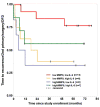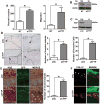Inactivation or loss of TTP promotes invasion in head and neck cancer via transcript stabilization and secretion of MMP9, MMP2, and IL-6
- PMID: 23349315
- PMCID: PMC3594656
- DOI: 10.1158/1078-0432.CCR-12-2927
Inactivation or loss of TTP promotes invasion in head and neck cancer via transcript stabilization and secretion of MMP9, MMP2, and IL-6
Abstract
Purpose: Invasion is the critical step in progression of a precancerous lesion to squamous cell carcinoma of the head and neck (HNSCC). Invasion is regulated by multiple proinflammatory mediators. Tristetraprolin (TTP) is an mRNA-degrading protein that regulates multiple proinflammatory mediators. TTP may serve as an excellent treatment target. Rap1 is a ras-like oncoprotein that induces critical signaling pathways. In this study, the role of rap1 in TTP-mediated invasion was investigated.
Experimental design: Using complementary approaches, we modulated TTP and altered expression of interleukin (IL)-6 and matrix metalloproteinase (MMP) 2/9, which were quantified by ELISA and zymogram. Invasion was evaluated in vitro using the oral-cancer-equivalent (OCE) three-dimensional model and in vivo in the chick chorioallantoic membrane (CAM). The role of rap1 and p38 were established using knockdown strategies.
Results: Downregulation of TTP significantly increased invasion via secretion of MMP9/2 and IL-6. In the novel OCE and CAM invasion models of HNSCC, cells with downregulated TTP destroyed the basement membrane to invade the underlying connective tissue. Rap1 induces p38 mitogen-activated protein kinase (p38)-mediated inactivation of TTP. Inactive TTP enhances transcript stability via binding to the 3'-untranslated region (UTR). High IL-6 and MMP9 are prognostic for poor clinical outcomes in patients with HNSCC.
Conclusions: Targeting the rap1-p38-TTP cascade is an attractive novel treatment strategy in HNSCC to concurrently suppress multiple mediators of invasion.
©2012 AACR.
Conflict of interest statement
Figures






References
-
- Leemans CR, Braakhuis BJ, Brakenhoff RH. The molecular biology of head and neck cancer. Nat Rev Cancer. 2011;11:9–22. - PubMed
-
- Jemal A, Siegel R, Xu J, Ward E. Cancer statistics, 2010. CA Cancer J Clin. 2010;60:277–300. - PubMed
-
- Badache A, Hynes NE. Interleukin 6 inhibits proliferation and, in cooperation with an epidermal growth factor receptor autocrine loop, increases migration of T47D breast cancer cells. Cancer Res. 2001;61:383–91. - PubMed
-
- Kanazawa T, Nishino H, Hasegawa M, Ohta Y, Iino Y, Ichimura K, et al. Interleukin-6 directly influences proliferation and invasion potential of head and neck cancer cells. Eur Arch Otorhinolaryngol. 2007;264:815–21. - PubMed
-
- Hanahan D, Weinberg RA. Hallmarks of cancer: the next generation. Cell. 2011;144:646–74. - PubMed
Publication types
MeSH terms
Substances
Grants and funding
LinkOut - more resources
Full Text Sources
Other Literature Sources
Medical
Miscellaneous

